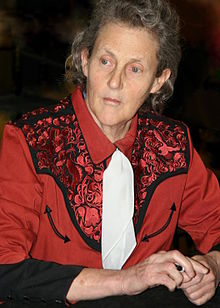Temple Grandin
Temple Grandin | |
|---|---|
 | |
| Born | Mary Temple Grandin August 29, 1947 Boston, Massachusetts, U.S. |
| Alma mater | Franklin Pierce University Arizona State University University of Illinois, Urbana-Champaign |
| Known for | Work in the livestock industry |
| Scientific career | |
| Fields | Animal science |
| Institutions | Colorado State University |
Mary Temple Grandin (December 3, 1947) is an American animal scientist and autism activist. She inspires many people.[1] She found similarities between animals and people with autism.[2] With these, she created stress-relieving methods. She normalized autism and improved autism research. She also improved livestock methods.[2]
Early life
[change | change source]Grandin grew up in Boston with her parents Richard Grandin and Eustacia Cutler. Her father was a real estate agent. Her mother was a writer, singer, and actress. She was born on August 29, 1947. She was diagnosed with autism in 1950. She first spoke at four.[1] She is an advocate for people with autism. Because of her autism, Temple did not think in words, she thought in pictures. In the early 1950s, most autistic children were discriminated against, but Grandin’s parents were very supportive of their daughter’s education. They sent her to multiple private schools. In Highschool, she created her first stress relieving device. This machine is still used today.[2] In 1970, she graduated with honors and a Bachelor of Arts from Franklin Pierce College. Grandin received a doctorate in animal science in 1989 from the University of Illinois. After receiving her master’s degree in 1975, she created her own company, called Grandin Livestock Handling Systems. She continued learning about animal cruelty through this company.
Career
[change | change source]Grandin worked most of her life to help the cruel living conditions of livestock. She worked on ways to prevent putting stress on animals before slaughter (when they are killed to be used for meat). Considering Grandin was autistic, she noticed the similarities in the way animals and autistic people saw the world, which let her help the cause even more. She's been a professor for over 20 years. She has taught animal science at Colorado State University since 1990.
Grandin wrote her first book with the help of Catherine Johnson. After having lots of success with her first book, she had a three-hour interview with Johnson. Later that year, a movie was released about her life. In that same year, Grandin was included in TIME's Top 100 Influential People. Grandin also wrote a book with Richard Panek in 2013 called The Autistic Brain: Thinking across the Spectrum, which was about differences found in the brains of those who are autistic.
Achievements
[change | change source]Because Grandin's achievements are so great, many parents of autistic children are inspired by her. Her autism may have been difficult at times, but it has also given her unusual advantages. During her career she has come up with humane conditions for the handling of animals. Grandin is motivated by a wish to improve animal welfare by getting rid of unnecessary stress on domestic animals, particularly before and during slaughter. She has won lots of awards. The National Woman's Hall of Fame nominated her in 2017. She has written books. She had a Ted Talk about understanding autism.
Later work
[change | change source]Grandin is a professor of animal science at Colorado State University. She has focused on animal well-being throughout her career. She has been hired as a consultant to the meat industry (animal slaughtering). Grandin recommends "well-designed upright or rotating restraining pens" to hold cattle in a comfortable position. If this is done, 95 percent or more of the animals will stay calm. She thinks from a cow’s perspective to come up with her ideas. For example, she considers the animal’s sensitivity to light and slippery surfaces. She has said that soft lighting and single-colored walls help calm the animals. Also, she has said grooved floors are best, because cows are scared of slippery floors.
References
[change | change source]- "Temple Grandin."[permanent dead link] Newsmakers, Gale, 2006. Student Resources in Context, link.. Accessed 28 Mar. 2017.
